China-ASEAN Financial Cooperation Network: Structure, Evolution and Influencing Factors
-
摘要:
基于2000—2022年GDELT全球新闻数据构建中国—东盟金融合作网络,并运用地层约束聚类、社会网络分析和QAP回归等方法分析网络的结构、演化及影响因素,发现:中国—东盟金融合作网络受亚洲金融危机、全球金融危机和逆全球化思潮抬头等宏观环境变动影响,金融合作程度由持续上升转向波动性下降,呈现“缓慢增长”“积极融入”和“逐步调整”的阶段演化特征。中国—东盟金融合作网络存在内部不均衡、地理邻近优先和“金字塔”式程度级差的结构特征。整体网络结构日益紧密,小世界性特征愈加明显;局部网络结构趋向稳定,内部群体分化逐渐缩小;个体网络结构的各国重要性不断上升,中国、泰国、越南、马来西亚4国占据主导地位,发挥“桥梁”作用。中国—东盟金融合作网络受贸易往来程度、金融发展距离、经济邻近性、制度距离、市场化距离、语言邻近性、宗教邻近性、地理邻近性、信息化发展、交通发展和数字经济发展距离11个因素共同作用。但经济邻近性、金融发展距离和数字经济距离3个因素对中国—东盟金融合作网络仅存在阶段性影响。
Abstract:Based on the 2000-2022 GDELT mass media data, this paper constructed the financial cooperation network of China-ASEAN and analyzed its structure, evolution characteristics, and influencing factors. The results indicate that: 1) The network has been influenced by macro-environmental changes such as the Asian financial crisis, the global financial crisis, and the rise of anti-globalization trends. It shows an evolution from a continuous rise to a fluctuating downward trend, reflecting "slow growth", "active integration", and "gradual adjustment" stages. 2) The China-ASEAN financial cooperation network exhibits internal imbalance, geographical priority proximity, and has a pyramid hierarchical distribution. Overall, the China-ASEAN financial cooperation network has become increasingly close with a more obvious small-world character. At the local level, internal groups have narrowed gradually. At the individual level, the importance of each country has risen. Particularly, China, Thailand, Vietnam, and Malaysia dominate the network and act as "bridges". 3) Financial development distance, degree of trade, economic proximity, institutional distance, marketization distance, language proximity, religious proximity, geographical proximity, informatization, transportation development, and digital economy distance are important factors affecting China-ASEAN financial cooperation. However, economic proximity, financial development distance, and digital economy distance have stage effects on the China-ASEAN financial cooperation network.
-
一. 问题的提出
自2008年全球金融危机爆发以来,“逆全球化”思潮不断加剧,以发达国家为主的单边主义、贸易保护主义、金融霸权主义接连发生。在此背景下,各国经济体对区域经济一体化的需求日益迫切,区域金融合作的重要性进一步凸显。学术界有关区域金融合作的文献较多,主要包括区域金融合作的动因[1]、合作模式[2]、发展历程[3]、现实挑战[4]、作用意义[5]等方面。其中,一些学者聚焦于测度区域金融合作程度,量化区域国家间金融合作关系研究。比如,Wu和Pan基于中国的投资需求和“一带一路”共建国家的融资需求,测算中国与“一带一路”共建国家的金融合作水平[6];刘方和丁文丽从货币合作、金融基础设施合作、金融市场合作、金融监管合作与金融机构合作5个层面计算中国—东盟金融合作指数[7]。尽管现有研究度量了区域金融合作程度,能够反映一国在不同区域的金融合作水平差异,但这些研究往往局限于单向和二元关系,忽略了区域金融合作是金融活动相互作用下的多边行为。此外,区域金融合作受异质性因素影响,合作程度呈多元化特征,在空间层面形成了由多个“点”“线”连接而成的复杂网络体系。因此,有必要在网络分析框架下深入探讨区域金融合作网络的结构、演化及其影响因素。
近年来,随着经济学、金融学与复杂网络科学的跨学科融合发展,基于网络分析方法研究经济合作网络、金融合作网络、区域金融合作网络取得了一定进展。其中,经济合作网络研究涵盖广泛,包括贸易关系[8-9]、跨境投资[10-11]、经济制度[12]等合作网络的结构、演化及影响因素。如Fagiolo等运用社会网络分析法研究全球贸易合作网络,指出国家间贸易合作水平差异较大,网络呈现明显的“核心—外围”结构[13];黄晓东等发现,全球跨境并购网络的空间格局与全球经济格局演化相似,并采用QAP回归方法从邻近关系和国家属性两个层面揭示了跨境并购网络的形成机制[14]。金融合作网络研究多以外汇交易[15]、货币互换协议[16]、金融机构[17-18]等单一金融资源要素为研究对象,探讨参与主体在合作网络中的角色地位,以及影响网络演化的驱动因素。如Lin等根据中国签署双边货币互换协议构建货币合作网络,指出贸易强度、经济规模、战略伙伴关系和自由贸易协定等是影响货币合作网络演化的重要因子[19]。Liu等使用SWIFT数据中的结算货币信息建立货币合作网络,测度了美元、欧元、英镑、日元和人民币之间的溢出效应,发现人民币尚未成为具有全球知名度的国际货币,但已具备显著的区域影响力。其中,人民币在东盟国家占主导地位,密切的实体经济联系是强化人民币在东盟国家网络地位的关键[20]。Pan等基于APS企业(如证券公司、律师事务所和会计事务所)在上市公司首次公开发行过程中提供服务联系的视角,构建城市金融合作网络,发现北京、上海、深圳在中国城市金融合作网络中居战略主导地位[21]。区域金融合作网络研究仅有少量的理论成果散见于文献之中,既缺乏对“多元一体”网络的系统研究,也鲜见网络实证分析[22],研究区域也局限在“一带一路”共建国家[23]、亚欧地区[24]、东亚地区[25]、东盟与周边区域[26]等。如魏玲认为,从东盟双边货币互换到多边货币互换,再到国际组织管理,以东盟为中心的区域金融合作网络已逐渐壮大[27];云倩指出,中国与东盟的双边金融机构网络化布局已初见成果[28];周进通过梳理中国与“一带一路”共建国家的货币合作进展,认为中国与“一带一路”共建国家已形成层次清晰、初具规模的区域金融合作网络[29]。总体而言,区域金融合作网络由货币、金融机构等多种金融资源共同构成,是一个复杂、庞大的多边交互系统,但关于区域金融合作网络的研究不仅缺少网络视角下区域金融合作程度的度量评价体系,也缺乏区域金融合作网络结构、演化及其影响因素的系统研究。
中国与东盟互为最大贸易伙伴,该区域具备深化金融合作的现实需求、历史基础和区位优势。本文从金融合作网络视角剖析中国—东盟金融合作问题,运用地层约束聚类、社会网络分析及QAP回归等分析方法,研究中国—东盟金融合作网络的结构、演化及其影响因素,以评估各国金融合作关系和相互作用,廓清各国在中国—东盟金融合作网络中的地位,揭示国家间金融合作变化影响机理,为进一步深化中国—东盟金融合作、推进区域经济一体化提供理论启示和实践指导。
二. 中国—东盟金融合作网络的结构
一 网络构建
中国—东盟通过签署经贸协定、设立跨境金融部门、提供援助性金融支持等方式,实现区域金融资源跨境流通,形成了复杂的金融合作联系。考虑到中国—东盟金融合作内容的多样性和难以量化性,本文充分利用互联网时代新闻媒体实时抓取内容信息并时效报道的特点,从GDELT(The Global Database of Events, Language, and Tone)数据库①获取了2000—2022年中国—东盟经济金融合作的相关新闻共计100 321条(见表 1)。通过中国—东盟金融合作新闻数量和新闻类型对应的戈尔德斯坦指数②进行综合赋值,度量中国—东盟金融合作程度,建构无向的中国—东盟金融合作网络。具体而言,中国—东盟金融合作网络是由“连线”和“节点”共同构成,在空间上形成国家间互联互通的金融合作网络。其中,“连线”指中国—东盟区域内11个国家间的金融合作程度,“节点”指中国—东盟区域内该国与余下10国的金融合作程度总额,见式(1)、式(2)。
Fij(t)=6∑p=1[fijp(t)×Gp](i≠j) (1) Fi(t)=10∑j=1Fij(t) (2) 表 1 GDELT事件类型及含义类型 事项 评分 含义 口头合作 呼吁经济合作(0211) 3.4 呼吁、请求或建议建立或扩大经济联系,如请求发展或扩大贸易和其他形式的经济交换 呼吁经济援助(0231) 3.4 呼吁、请求或建议经济援助,如贷款或债务减免的请求或建议 表达经济合作意愿(0311) 5.2 提供、承诺、同意或以其他方式表明参与或扩大经济联系的意愿或承诺,如发展或扩大贸易和其他形式的经济交换的协议、承诺或其他意图的指示 表示愿意提供经济援助(0331) 5.2 提供、承诺、同意或以其他方式表明愿意或承诺提供经济支持,如以赠款、贷款或债务减免的形式提供财政支持的准则承诺 物质合作 展开实质性经济合作(061) 6.4 发起、恢复、改善或扩大经济交流或合作 提供经济援助(071) 7.4 提供货币援助和财政担保、赠款和信贷 资料来源:GDELT官网(http://data.gdeltproject.org/documentation/CAMEO.Manual.1.1b3.pdf)中“CAMEO事件分类表”对事件的详细介绍。其中,“事项”栏中数值代表事件类型代码,即根据不同代码识别新闻所属类型;“评分”为GDELT中戈尔德斯坦量表对应事件类型的戈尔德斯坦指数评分。 其中,Fij(t)为“连线”,即第t年i国和j国的金融合作程度;Fi(t)为“节点”,即第t年i国与余下10国金融合作程度总额;fijp(t)为第t年i国和j国在p事件类型的合作总数量;Gp为p事件类型对应的戈尔德斯坦得分,即该新闻类型对i国和j国关系的重要程度;本文共有6类事件,p的取值范围为1—6。
二 网络结构
根据GDELT合作新闻测算出的中国—东盟金融合作程度,构建2000—2022年中国—东盟金融合作程度矩阵(见表 2),并可视化出中国—东盟金融合作网络拓扑结构(见图 1)。同时,利用自然间断点分级法将“连线”(即中国—东盟国家间金融合作程度)划分为5级,观测中国—东盟金融合作网络的层级分布(见表 3)。中国—东盟金融合作网络结构主要呈现三个特征。
表 2 2000—2022年中国—东盟金融合作程度矩阵国家 中国 马来西亚 泰国 越南 印度尼西亚 新加坡 菲律宾 柬埔寨 老挝 文莱 缅甸 均值 中国 - 50 839 40 162 46 822 40 192 33 838 13 929 22 774 10 529 5 370 9 263 27 372 马来西亚 50 839 - 15 555 10 487 29 969 29 783 9 359 3 780 940 3 662 870 15 524 泰国 40 162 15 555 - 26 710 14 493 9 142 9 617 12 246 9 000 1 495 6 655 14 507 越南 46 822 10 487 26 710 - 14 444 9 728 10 349 10 104 10 091 1 945 1 025 14 170 印度尼西亚 40 192 29 969 14 493 14 444 - 15 974 12 441 2 030 887 2 457 595 13 348 新加坡 33 838 29 783 9 142 9 728 15 974 - 5 896 3 146 859 2 519 1 229 11 211 菲律宾 13 929 9 359 9 617 10 349 12 441 5 896 - 1 747 1 186 5 036 256 6 982 柬埔寨 22 774 3 780 12 246 10 104 2 030 3 146 1 747 - 5 612 1 308 577 6 332 老挝 10 529 940 9 000 10 091 887 859 1 186 5 612 - 891 630 4 062 文莱 5 370 3 662 1 495 1 945 2 457 2 519 5 036 1 308 891 - 19 2 470 缅甸 9 263 870 6 655 1 025 595 1 229 256 577 630 19 - 2 112 均值 27 372 15 524 14 507 14 170 13 348 11 211 6 982 6 332 4 062 2 470 2 112 10 736 表 3 2000—2022年中国—东盟金融合作程度层级分布等级 金融合作联系 金融合作程度均值 1 中国—马来西亚;中国—泰国;中国—越南;中国—印度尼西亚 44 503.59 2 中国—新加坡;中国—柬埔寨;马来西亚—印度尼西亚;马来西亚—新加坡;泰国—越南 28 614.84 3 中国—菲律宾;马来西亚—泰国;泰国—印度尼西亚;泰国—柬埔寨;越南—印度尼西亚;印度尼西亚—新加坡;印度尼西亚—菲律宾 14 154.47 4 中国—老挝;中国—缅甸;中国—文莱;马来西亚—越南;马来西亚—菲律宾;泰国—新加坡;泰国—菲律宾;泰国—老挝;泰国—缅甸;越南—新加坡;越南—菲律宾;越南—柬埔寨;越南—老挝;新加坡—菲律宾;柬埔寨—老挝 8 746.69 5 菲律宾—柬埔寨;菲律宾—老挝;菲律宾—缅甸;菲律宾—文莱;柬埔寨—马来西亚;柬埔寨—印度尼西亚;柬埔寨—新加坡;柬埔寨—缅甸;柬埔寨—文莱;老挝—马来西亚;老挝—印度尼西亚;老挝—新加坡;老挝—缅甸;老挝—文莱;马来西亚—缅甸;马来西亚—文莱;缅甸—越南;缅甸—印度尼西亚;缅甸—新加坡;缅甸—文莱;泰国—文莱;文莱—越南;文莱—印度尼西亚;文莱—新加坡 1 628.78 1 中国—东盟金融合作网络存在内部不均衡性
如表 2所示,从国家之间的金融合作程度来看,中国—东盟金融合作主要集中在“中国—马来西亚”“马来西亚—印度尼西亚”“泰国—越南”等发展较好的国家之间,而大部分国家与老挝、文莱和缅甸的金融合作联系相对较低。其中,中国、马来西亚、泰国金融合作程度均值分别为27 372、15 524和14 507,而老挝、文莱和缅甸金融合作程度均值分别为4 062、2 470和2 112,区域内国家金融合作程度差距明显。
2 中国—东盟金融合作网络存在地理邻近优先性
如图 1所示,从金融合作网络拓扑结构来看,无论是欠发达国家还是发展较好国家,各国普遍与相邻国家金融合作联系密切。这说明各国在选择金融合作伙伴时,会优先考虑地理邻近国家。因为双方在往来上具有先天区位优势,有助于增加主体之间面对面交流和互动的机会,使双方在经济、文化、制度上更具共识,金融合作效率更高。同时,双方也因为共同的边界利益而在合作上更加积极,进而双方金融合作更为紧密。
3 中国—东盟金融合作网络呈现“金字塔”式程度级差结构
如表 3所示,从金融合作程度级差来看,国家间高等级金融合作程度远高于低等级金融合作程度;但国家间高等级金融合作联系数量显著低于低等级金融合作联系数量,且伴随国家间金融合作等级的下降,国家间金融合作联系数量持续增加。具体而言,最高等级的国家间金融合作关系仅包含“中国—马来西亚”“中国—泰国”“中国—越南”“中国—印度尼西亚”4组,金融合作程度均值高达44 503.59;而最低等级的国际金融合作关系包含“菲律宾—柬埔寨”“柬埔寨—马来西亚”“老挝—马来西亚”“缅甸—越南”“泰国—文莱”“文莱—越南”等24组,金融合作程度均值仅为1 628.78。
三. 中国—东盟金融合作网络的演化特征
一 研究方法
1 地层约束聚类
本文采用地层约束聚类法观测中国—东盟金融合作网络的阶段演化特征。地层约束聚类的基本思想是在考虑相邻的基础上,将每个样本视为单独一类,根据合并后类内方差增量最小的原则进行凝聚聚类,直至所有样本聚成一类,实现时间序列分段,目前已应用于地缘关系研究等领域[30]。该方法既考虑了中国—东盟国家间相邻的特点,还克服了人为进行阶段划分的主观性与不同国家本身政治和经济因素演进的独特进程的影响[31]。具体而言,先计算第p类类内利差平方和Dp,再计算将样本划分为k类后总的离差平方和D,最后将相邻的p类和q类合并,组成新的pq类,计算最小方差增量Ipq。公式如下:
Dp=np∑i=1m∑j=1(xpij−ˉxpj)2 (3) D=k∑p=1Dp (4) Ipq=Dpq−Dp−Dq (5) 其中,np为第p类的样本数量,即年份数量;m指国家数量;xpij为第p类第i个样本的第j个变量的观测值,指p阶段内第i年j国与其他国家金融合作程度占该年所有国家间金融合作程度比值的1/2;xpj为p类中变量j的平均值,指p阶段j国的金融合作程度均值。
2 社会网络分析
社会网络分析法是关系网络研究的主要方法之一[32]。本文采用社会网络分析法对2000—2022年中国—东盟金融合作网络的结构演化特征进行分析。具体而言,从整体层面选择网络密度、平均度、平均最短路径和聚集系数指标,从局部层面选择迭代相关收敛法,从个体层面选择度数中心度和接近中心度指标,具体见表 4。
表 4 社会网络分析相关指标类别 指标 公式 作用 整体 网络密度(D) D=2mn(n−1) 衡量网络联系的紧密程度,网络密度越大,网络联系越紧密 平均度(N) N=1nn∑j=1Xij(i≠j) 反映一个网络中各节点直接关联程度,平均度越大,意味着各节点与其他节点连接程度越大 平均最短路径(L) L=2n(n−1)∑i≥jdij 指任意两点间在网络中最短路径的平均长度,反映金融合作网络的连通性 聚集系数(C) C=1nn∑i=1eiki(ki−1) 指网络联系的集聚程度,反映金融合作网络的凝聚能力 局部 迭代相关收敛法(CONCOR) 通过对矩阵中各行(或列)之间的相关系数进行重复计算,将相关系数相同的个体划归至一个板块 识别联系较为紧密的小团体 个体 度数中心度[CD(Ni)] CD(Ni)=p∑j=1xijp−1(x≠j) 指某国金融合作联系的相对活跃程度,反映该国在网络中的重要性 接近中心度(CAPi-1) C−1APi=n∑i=1dij 反映某国控制金融合作网络中其他国家之间交往的能力。其中,接近中心度数值越大,代表该点在整个网络中越边缘化 注:m为网络中实际关系总数,n为网络节点总数,Xij为节点i和节点j相连的节点数量,dij为节点i到节点j的最短距离,ei为节点i直接联系的边数,ki为邻接点数,ki(ki-1)为最大可能边数,xij为节点i和节点j的关联数,p-1为理论最大关系数。 二 网络阶段演化特征
通过运用地层约束聚类方法,中国—东盟金融合作网络呈现三个演化阶段,具体如图 2所示。
第一阶段(2000—2008年):缓慢增长阶段,即中国和东盟国家的金融合作程度普遍不高。该阶段发生在1997年亚洲金融危机后。以货币危机为源头的流动性短缺导致泰国、马来西亚、印度尼西亚等国货币大幅贬值,东盟国家金融机构濒临破产。东盟国家意识到区域机构不够统一、区域体制结构存在缺陷是难以抵御此次危机的主要原因,因此强调了加强包括中国在内的区域经济依赖的必要性。如1999年马来西亚总理马哈蒂主张建立“东南亚货币基金”,构建区域金融安全网;2000年东盟及中、日、韩(10+3)财长会议提出“清迈倡议”(CMI),加强亚洲货币金融合作。然而,这些合作主要是危机驱动的被动防护,缺乏平衡成员国经济的有效机制。加之成员国间经济差异和增长不平衡,使得金融一体化进展缓慢,导致区域金融合作在危机后未能发挥实质作用。
第二阶段(2009—2014年):积极融入阶段,即中国和东盟国家的金融合作程度快速增强。第二阶段发生在2008年全球金融危机后。伴随世界经济陷入“低增长、低利率、低通胀、高债务”的“三低一高”格局,深度融入经济全球化的中国与东盟国家金融风险显著攀升。同时,受西方发达经济体债务率不断攀升影响,中国与东盟国家被迫减少对西方市场的依赖,转而聚焦区域合作。此后,中国与东盟国家加强区域金融和货币合作,推动了区域经济一体化进程。2010年,筹划了8年的中国—东盟自由贸易区正式启动,深化了中国—东盟以实体经济为基础的金融联系。同年,CMI升级为共同决策、储备资金多边化的“清迈倡议”多边机制(CMIM),资金规模由800亿美元上升至1 200亿美元,并在2014年进一步扩容至2 400亿美元。
第三阶段(2015—2022年):逐步调整阶段,即中国和东盟国家金融合作程度在初期上升后呈现波动性下降。这一阶段的时代背景是世界经济格局由经济全球化向逆全球化转向。尤其是在2016年多起“黑天鹅事件”发生之后,逆全球化趋势加剧,保护主义盛行,地缘政治关系更趋复杂。其中,东盟国家位于印度洋和太平洋之间,既是中国经略周边关系的重中之重,也是美国“亚太再平衡”战略的核心关键。面对大国竞争的不确定性挑战,东盟国家通常采取积极寻求强国的军事保护和加深邻国合作的“大国平衡”战略,以维持稳定而审慎的合作进展。因此,特别是在2018年中美贸易摩擦后,中国与东盟的金融合作逐步放缓,更趋向于防御和稳定为主导,以适应不断变化的国际格局。
三 网络结构演化特征
本文将2000—2022年中国—东盟金融合作程度矩阵经过二值化处理后,运用Ucinet软件,选择社会网络分析法对中国—东盟金融合作的整体网络结构、局部网络结构和个体网络结构演化特征展开分析。
1 整体网络结构层面,中国—东盟金融合作网络日益紧密,小世界性特征愈加明显
如表 5所示,从网络连通性来看,中国—东盟金融合作网络密度和平均度分别由0.382和4.200上升至0.455和5.556,反映出中国—东盟国家间关系日趋紧密,网络结构凝聚力逐渐提升。尤其是在2008年全球金融危机之后,中国—东盟金融合作网络密度迅速增加,说明区域各国在依赖发达国家的同时,开始逐渐将发展重心向区域一体化转变。从便捷度来看,中国—东盟金融合作网络的平均最短路径由1.622下降至1.306,说明越来越多国家能够便利展开直接合作,双边关系逐渐改善,金融合作效率日益提升。此外,随着聚集系数越来越大,平均最短路径持续下降,意味着中国—东盟金融合作网络节点间的通达性和集聚性不断变强,小世界性特征趋势显现。
表 5 2000—2022年中国—东盟金融合作整体网络结构阶段 网络密度 平均度 聚集系数 平均最短路径 2000—2008年 0.382 4.200 0.775 1.622 2009—2014年 0.436 5.333 0.846 1.333 2015—2022年 0.455 5.556 0.853 1.306 2 局部网络结构层面,中国—东盟金融合作网络内部群体分化逐渐缩小,网络内部结构趋向稳定
如表 6所示,在第一阶段,中国—东盟金融合作网络分为4个凝聚子群。其中,第Ⅳ子群仅包括文莱这一个国家,其金融合作程度总额最低,与其他国家联系最少,为“边缘区”;第Ⅱ子群的新加坡、菲律宾、马来西亚、印度尼西亚和第Ⅲ子群的缅甸、老挝、柬埔寨、越南,受地理邻近便利和经济相似驱使,在区域内形成了两个联系紧密的金融合作团体。第Ⅰ子群的中国和泰国联系紧密的原因在于,一方面,泰国在亚洲金融危机中率先经历了严重的资本外流和货币贬值,与中国资本管制下的货币相对稳定形成对比,使双方认识到加强区域金融合作,以增强抵御外部冲击能力的重要性;另一方面,泰国不仅地处东盟地区的中心位置,还拥有相对发达的金融市场和开放的经济政策,使其成为连接中国与东盟其他国家的重要枢纽。通过加强与泰国的金融合作,中国得以更有效地联系和助力整个东盟地区的经济发展。
表 6 2000—2022年中国—东盟金融合作网络的凝聚子群及演化阶段 凝聚子群Ⅰ 凝聚子群Ⅱ 凝聚子群Ⅲ 凝聚子群Ⅳ 2000—2008 中国、泰国 新加坡、菲律宾、马来西亚、印度尼西亚 缅甸、老挝、柬埔寨、越南 文莱 2009—2014 中国、泰国、越南、印度尼西亚、马来西亚 新加坡、菲律宾、缅甸、柬埔寨 文莱、老挝 - 2015—2022 中国、泰国、越南 新加坡、菲律宾、马来西亚、印度尼西亚、柬埔寨、老挝 文莱、缅甸 - 在第二、三阶段,中国—东盟金融合作网络从4个子群缩减为3个子群,区域内部紧密度显著增强,区域网络的凝聚力进一步提高。其中,凝聚子群Ⅰ、Ⅱ、Ⅲ根据金融合作程度划分为“活跃区”“次活跃区”和“边缘区”。具体而言,“活跃区”的中国、泰国和越南始终没有发生变动,反映出三者合作较为密切,已形成较为稳定的内部联系结构。一方面,中国、泰国和越南同属大湄公河次区域经济合作、澜沧江—湄公河合作等多个区域经济合作机制,具备金融合作的物质基础;另一方面,各方经贸往来规模庞大,为金融合作创造了大量现实需求。2022年统计数据显示,中国是泰国和越南最大的贸易伙伴,越南是泰国在东盟的第二大贸易伙伴,泰国是越南在东盟的第一大贸易伙伴和第二大外资来源国。“次活跃区”被定位为“活跃区”与“边缘区”的过渡地带。在这一区域,各国对中国—东盟金融合作网络的态度往往是基于中美竞争的战略平衡,即积极响应域内国家金融合作倡议的同时,也热衷于推动与域外国家的友好合作关系。“边缘区”的老挝和缅甸实现互换,其原因主要是老挝与中国共签“一带一路”倡议,为金融合作发展提供了广阔空间。特别是2021年底中老铁路开通,极大便利了周边国家与老挝的经济合作与金融合作,使老挝向“次活跃区”转变。相反,缅甸近年来内乱不断和政治不稳定,恶化了中国及东盟地区的地缘安全不确定性,导致各国与缅甸合作减少,该国在区域网络中一直处于边缘地位。
3 个体网络结构层面,中国—东盟金融合作网络中各国重要性不断上升,直接合作能力明显提高
如表 7所示,从度数中心度来看,2000—2022年度数中心度由38.182提高至45.455,说明单个国家对网络的重要性普遍增强。在这三个阶段中,中国、泰国、越南、马来西亚和印度尼西亚均高于平均水平,意味着这五个国家与区域内其他国家开展了较多金融合作,是区域金融合作网络强化的关键节点,对促进区域金融合作发展至关重要。而老挝、缅甸和文莱的度数中心度排名最后,说明这三个国家与区域内其他国家金融合作联系较少,在区域网络中处于“被接受方”。从接近中心度来看,2000—2022年接近中心度由64.665上升至76.528,表示网络中的中介“桥梁”作用减少,对中介节点的依赖下降,国家间的直接交流能力增强。在第一阶段,中国、泰国和马来西亚扮演着“中心行动者”角色,协调区域金融合作网络连接,对整个网络资源流动起着重要引导作用。但在第二、三阶段,马来西亚接近中心度提高,中国—东盟金融合作网络由越南、中国、泰国共同发挥中介作用,原因可能在于越南拥有生产和分配货物的海陆战略性位置,吸引了大量外商投资并承接了制造工厂转移机遇,得以间接加大越南与区域其他国家的金融合作。
表 7 2000—2022年中国—东盟金融合作网络中的国家中心度演变2000—2008年 2009—2014年 2015—2022年 度数中心度 接近中心度 度数中心度 接近中心度 度数中心度 接近中心度 中国 80.000 53.361 80.000 65.175 80.000 66.664 泰国 70.000 53.869 80.000 65.175 70.000 67.238 越南 50.000 60.282 60.000 66.540 80.000 66.664 马来西亚 40.000 59.621 60.000 66.736 60.000 68.482 印度尼西亚 40.000 60.904 60.000 66.736 60.000 68.482 菲律宾 20.000 65.662 40.000 67.901 50.000 69.656 新加坡 40.000 60.629 40.000 68.871 40.000 70.443 柬埔寨 30.000 62.540 30.000 70.371 30.000 72.090 老挝 30.000 62.540 0.000 110.000 30.000 72.090 缅甸 20.000 61.909 20.000 71.741 0.000 110.000 文莱 0.000 110.000 0.000 110.000 0.000 110.000 均值 38.182 64.665 43.636 75.386 45.455 76.528 四. 中国—东盟金融合作网络的影响因素
一 模型构建
1 QAP回归
本文采用QAP回归(Quadratic Assignment Procedure)对中国—东盟金融合作网络的影响因素进行分析。QAP回归是一种非参数检验方法,专门用于分析关系数据,已广泛应用于关系网络的影响因素研究[33]。相比传统的多元统计分析方法,该方法能够有效地处理变量间的自相关性和多重共线性问题,尤其适合分析个体间的相互关系数据,如网络节点之间的联系[34]。
2 指标选取
基于区域金融合作理论,两国间金融合作关系普遍受到经济、政治(制度)、文化和基础设施等多维度诸多因素的共同影响。借鉴已有研究成果[35-37],结合中国—东盟金融合作的现实需求,基于科学性、全面性和可获得性原则,选取经济、政治(制度)、文化和基础设施4个维度的11个因子进行识别分析。
经济关系是构建中国—东盟金融合作网络的前提条件,金融交易建立在频繁的经贸往来基础之上。借鉴杜婕等[38]的研究,选取贸易往来程度、经济邻近性、金融发展距离作为经济维度的影响因子。
政治(制度)关系是中国—东盟金融合作关系的重要保障,一方面,复杂动荡的国内外政治局势制约投资者资本流动,阻碍两国金融合作正常开展;另一方面,制度环境的相似性与开放性对逐利的国际资本有重要吸引力,因为其能减少不同市场规则的适应需求,降低法律合规风险,影响两国金融交易成本。借鉴黄祥钟等[39]的研究,选取制度距离③、市场化距离④作为政治(制度)维度的影响因子。
文化关系是中国—东盟金融合作关系的重要纽带,特别是语言和宗教信仰对双方沟通效率影响显著,对建立伙伴关系、维系金融合作长效稳定起着支持作用。借鉴郑筱筠[40],Pan和Zhang[41]的研究,选取语言邻近性和宗教邻近性作为文化维度的影响因子。
基础设施水平是影响中国—东盟金融合作效率的外部推力,中国—东盟金融合作离不开资金、人员、技术等金融资源的跨境流通,需要网络通信、交通工具等载体作为依托。特别是在科技发展日新月异的背景下,信息化、数字化技术更是为金融服务创新赋予了加速度。此外,早期中国—东盟金融合作源于两国交界之处,两国的地理邻近为进一步深化金融合作关系奠定了坚实基础。借鉴Asongu和Moulin[42]、王梓利和林晓言[43]的研究,选取信息化发展距离、交通发展距离、数字经济发展距离和地理邻近性作为基础设施维度的影响因子[42-43]。
3 模型设定
根据上述分析,本文构建QAP回归模型,对促进2000—2022年中国—东盟金融合作网络形成的影响因素进行定量分析,如式(6)所示:
Y=f( Tra, Inf, Eco, Pol, Fre, Lan, Rel, Int, Trs, Dig, Geo ) (6) 其中,因变量Y为中国—东盟金融合作程度关系矩阵,将该值进行对数处理;所有变量值都是根据各个阶段包含的年数计算出的年均值;少部分变量缺失值用插值法填补;各影响因素的处理方法及数据来源如表 8所示。
表 8 中国—东盟金融合作网络影响因素维度 变量名称 矩阵构建方式 数据来源 经济 贸易往来程度(Tra) 两国进出口贸易总额,取对数值 UNCTAD数据库 金融发展距离(Inf) 两国金融发展水平指数的差值绝对值 国际基金组织 经济邻近性(Eco) 国民收入水平同属一组,赋值为1,否则为0 世界银行 政治(制度) 制度距离(Pol) 采用Kogut和Singh提出的距离计算方法[44],从世界银行测度的WGI指数的6个层面综合衡量两国制度发展水平差距 世界银行 市场化距离(Fre) 两国经济自由度指数的差值绝对值 弗雷泽研究所 文化 语言邻近性(Lan) 两国拥有共同的语言,赋值为1,否则为0 CEPⅡ数据库 宗教邻近性(Rel) 两国的主导宗教一致,赋值为1,否则为0 CIAWF数据库 基础设施 信息化发展距离(Int) 两国互联网个人用户数占总人口比重的差值绝对值 世界银行 交通发展距离(Trs) 两国航空运输客运量的差值绝对值,再取对数值 世界银行 数字经济发展距离(Dig) 两国宽带接入人数占总人数比值的差值绝对值 世界银行 地理邻近性(Geo) 两国国土接壤,赋值为1,否则为0 - 二 结果分析
本文运用Ucinet软件,分别对三个阶段的中国—东盟金融合作程度及影响因素矩阵进行QAP回归,结果见表 9。
表 9 2000—2022年中国—东盟金融合作网络影响因素2000—2008年 2009—2014年 2015—2022年 非标准化回归系数 标准化回归系数 非标准化回归系数 标准化回归系数 非标准化回归系数 标准化回归系数 Inf 1.038 5 0.146 5 0.538 2 0.061 8 0.285 8** 0.151 8** Tra 0.140 6*** 0.452 8*** 0.254 7*** 0.600 9*** 0.107 8** 0.190 5** Eco 0.438 9** 0.144 9** 0.054 1 0.015 0 -0.335 1 -0.086 3 Pol -0.186 7** -0.226 2** -0.190 8** -0.167 5** -0.340 3*** -0.274 9*** Fre -0.214 1** -0.170 9** -0.183 1* -0.119 6* -0.360 9*** -0.201 8*** Lan 0.350 9** 0.141 9** 0.235 7* 0.075 4* 0.372 2** 0.102 2** Rel 0.535 2*** 0.219 1*** 0.322 5** 0.104 5** 0.487 8*** 0.134 4*** Int -2.279 9*** -0.300 5*** -1.610 7*** -0.237 7*** -1.130 1*** -0.274 8*** Dig -0.104 9 -0.003 5 0.879 3 0.043 0 2.061 1** 0.099 4** Trs -0.124 5** -0.168 6** -0.169 1*** -0.188 2*** -0.284 9*** -0.222 1*** Geo 0.114 1** 0.041 0** 0.220 9* 0.062 9* 0.246 6** 0.059 8** Prob>chi2 0.000 0.000 0.000 R2 0.797 0.901 0.876 Adj_R2 0.776 0.891 0.863 注:***、**、* 分别表示系数通过了1%、5% 和10% 的显著性检验。 1 经济维度
两国贸易往来程度(Tra)在三个阶段皆显著为正,金融发展距离(Inf)在第三阶段显著为正,经济邻近性(Eco)在第一阶段显著为负。结果说明,两国贸易规模越大,双方对金融交易需求越多,越有助于双方金融合作。金融发展存在差异影响的原因在于,早期中国—东盟金融合作更多集中在实体经济交易,对金融基础设施水平和金融市场要求不高。但随着两国金融合作的持续推进,双方对金融制度、规则、技术等提出了更高的要求,金融发展水平差距越大,越有助于金融资源配置效率提高,使金融合作进一步深化。而经济邻近性在第一阶段显著为正,第二、三阶段转向失效,说明在早期阶段,中国—东盟金融合作倾向于发生在经济发展水平相近且较高的国家之间。但随着时间推移,该不均衡现象逐渐减少,金融合作在区域内趋向协同发展,不仅限于经济强国之间,也开始涉及经济发展水平不同的国家,进而带动区域经济一体化发展,中国—东盟金融合作网络的整体韧性得以增强。
2 政治(制度)维度
制度距离(Pol)和市场化距离(Fre)在三个阶段皆显著为负,说明两国制度距离和市场化距离小,越有利于中国—东盟金融合作。制度距离小代表两国政治关系相对稳定,在法律、政策和管理体系等方面更为接近,双方在法律和行政程序上的兼容性更高,跨国交易涉及的法律与行政成本更低。市场化距离越小意味着两国在市场准入、投资自由度和资本流动上的政策支持越为相似,两国的商业环境和市场规则越统一,双方在跨国金融合作层面越易达成共识。
3 文化维度
语言邻近性(Lan)和宗教邻近性(Rel)对中国—东盟金融合作网络有显著的正面影响。相似的语言意味着文化认同度更高,两国金融合作的交流障碍更低,有助于减少错误信息带来的风险,推动双方建立更深层次的合作意愿。共同的宗教信仰对文化交流和民心相通发挥着重要的积极作用,双方通过建立非正式的信任机制,增强两国人民的彼此尊重,助力金融合作正常开展。
4 基础设施维度
两国信息化发展距离(Int)和交通发展距离(Trs)在三个阶段显著为负,数字经济发展距离(Dig)仅在第三阶段显著为正,而地理邻近性(Geo)在三个阶段均呈现出积极影响。信息化发展水平差距越小,一定程度上反映了两国金融机构在处理和共享关键金融信息方面的能力越接近,越有利于减少因技术不兼容导致的误差和成本,促进跨境金融操作。交通发展距离对中国—东盟金融合作关系的影响体现在,随着交通基础设施的优化升级,两国间交通基础设施水平差距缩小,促进了人员、管理、技术的跨境流动,促进金融合作效率加快。数字经济发展距离对中国—东盟金融合作呈现阶段性影响,主要是因为早期各国数字经济发展起步较晚,各国宽带接入差距较小,难以对金融合作的建立与深化起到重要作用;而伴随各国经济持续发展,区域内部不平衡性逐渐突出,特别是数字经济领域的发展分化日益明显。数字经济作为金融科技发展的基石,其发展水平的高低直接影响金融创新的潜力和效率。因此,“优势方”通过技术、经验、资金等支持,带动“滞后方”数字经济发展,推动金融科技跨国融合创新,反而有助于双方深化金融合作。地理邻近性的积极影响在于,跨境金融交易往往率先源自两国交界处,依托边贸合作实现人员、资金等的频繁往来,相互信任得以增强,为深化两国间金融合作奠定基础。同时,地理位置接近也能显著降低跨境交易的运输和通信成本,提高金融合作效率。
五. 结论与启示
一 结论
本文基于GDELT大数据库构建中国—东盟金融合作网络,对2000—2022年区域网络的结构、演化及其影响因素进行分析,得出如下结论。
1 从总体上看,中国—东盟金融合作持续深化,区域金融合作程度受宏观环境影响变动
2000—2014年, 中国和东盟国家受亚洲金融危机和全球金融危机冲击驱使,各国意识到加强区域金融联系的重要性,中国—东盟金融合作程度不断上升;但伴随逆全球化思潮抬头,2015—2022年,中国和东盟国家金融合作程度短暂上升后呈波动性下降,区域金融合作进程转向稳慎。这主要是域内外复杂环境变化和大国竞争下的“平衡战略”选择影响,使中国—东盟金融合作进入逐步调整阶段。
2 从网络结构来看,中国—东盟金融合作网络存在内部不均衡、地理邻近优先以及“金字塔”式程度级差的结构特征
在演化层面,中国—东盟金融合作整体网络结构日益紧密,小世界性特征愈加明显。尤其是在2008年全球金融危机之后,中国—东盟金融合作网络密度显著提高,为中国—东盟区域经济一体化奠定坚实基础;中国—东盟金融合作局部网络结构趋向稳定,内部群体分化逐渐缩小。中国—东盟金融合作网络内部由第一阶段的4个凝聚子群缩减至3个凝聚子群,呈现出“活跃区”“次活跃区”和“边缘区”的金融合作程度阶梯式分布特征;中国—东盟金融合作个体网络结构中各国重要性不断上升,直接合作能力明显提高。中国、泰国、越南和马来西亚4国在网络中占据主导地位,发挥“桥梁”作用。
3 从影响因素来看,中国—东盟金融合作网络受到经济、政治(制度)、文化和基础设施4个维度因素的共同作用和影响
贸易往来程度、金融发展距离、经济邻近性、制度距离、市场化距离、语言邻近性、宗教邻近性、地理邻近性、信息化发展、交通发展和数字经济发展距离11个因子均对中国—东盟金融合作网络产生显著影响,对深化中国—东盟金融合作关系起着重要支持作用。但经济邻近性、金融发展距离和数字经济发展距离对中国—东盟金融合作网络仅存在阶段性影响。
二 启示
根据上述研究结论,本文得到三点启示。
1 防范域内、域外突发风险冲击
首先,提升中国—东盟金融合作网络韧性,通过共塑共同体共识的共同繁荣思想,加强政府间的信息共享、政策协调,推进区域经济一体化进程,提高抵御外部风险冲击能力。其次,高度重视国际复杂宏观环境变化,通过建立健全风险监测、预警、防控机制,对全球经济动态、金融市场波动、地缘政治冲突等潜在风险因素进行实时跟踪与分析,预测潜在风险对中国—东盟金融合作网络的可能影响,制定相应的应对策略和预案。最后,加强与域外国家沟通交流,通过主动建立“中国—东盟—第三方国家”友好协作论坛、智库合作等联系机制,探索中国—东盟国家和多边机制共存的金融合作模式,为中国—东盟金融合作网络的深化与扩大营造一个稳定、健康、可持续的国际环境。
2 促进网络各国协同发展
首先,推动建立更加包容和平等的合作机制,通过完善多层次合作框架,设立专门组织机构,确保所有成员国都能从金融合作中受益,避免“金字塔”式结构带来的不公平性。其次,利用地理邻近优势,深化相邻国家金融合作,特别是在跨境支付、货币清算、信贷融资等领域。同时,探索多边金融合作的新模式,如建立跨国金融服务中心、跨境金融创新试验区等,拓展中国—东盟金融合作广度、深度。最后,加强中国、泰国、越南、马来西亚等“活跃区”和“次活跃区”国家与老挝、缅甸、文莱等“边缘区”国家金融合作,通过协助健全金融制度、完善基础设施建设、发放低息贷款等多种方式,以金融合作拉动经济增长,缩小区域经济发展的不平等、不均衡。
3 加快各国“软”“硬”实力增质提效
首先,加强中国—东盟经济协调,以实体经济需求为导向,通过促进贸易和投资自由化、便利化,增强经济互补性,为金融合作奠定经济基础。同时,鼓励中资金融机构在东盟国家设立分支机构,通过提供多样化的金融服务,促进金融资源的优化配置和高效利用。其次,加强中国—东盟政治对话和高层互访,通过定期召开金融合作会议、设立专项基金、建立联合研究中心等方式,加强双方在金融政策、监管标准、产品创新等方面的协调合作,助力金融合作取得新成果。再次,尊重中国—东盟宗教文化差异,推动双方在文化、教育、旅游等领域的交流合作,增进相互理解、信任,为金融合作营造良好的社会氛围。最后,加强中国—东盟基础设施、民生项目等公共资源建设合作,推动各国互联互通,加强金融资源流通效率。特别是重视数字经济领域的基础设施合作,通过建设数字基础设施、制定数字标准、加强数据流动和监管合作等措施,共同探索数字金融、金融科技等新兴领域的发展机遇。
① GDELT数据库是一个全面记录事件和事件参与者的时空数据集,具有时效更新和数据来源丰富的优势。该数据库内容不仅每15分钟实时更新一次,还能从全球每个国家的大众媒体提取报道内容,自动识别、划分新闻内容的时间、人物、事件、语气等信息,刻画国家的角色和国际互动的行为特征。数据来源参见:https://blog.gdeltproject.org/gdelt-2-0-our-global-world-in-realtime/, 访问日期:2024年4月20日。
② GDELT数据库能将新闻内容自动划分为不同类型,并根据每个事件类型的影响大小对其进行差异赋值。其中,戈尔德斯坦指数是反映该类型的新闻事件对参与者间关系的重要程度的评分。
③ 制度距离从话语权与问责、政治稳定与非暴力、政府效率、监管质量、法治、控制腐败6个维度进行综合度量,该指标既反映了两国政治关系,也反映了两国制度环境差距。数据来源参见:https://www.worldbank.org/en/publication/worldwide-governance-indicators, 访问日期:2024年4月10日。
④ 市场化距离,又称经济自由度指数。该指数从政府规模、法律结构与产权保护、货币政策合理性、对外交往自由度及信贷、劳动力与商业管制5个维度进行综合度量,反映了国家经济活动自由与政府干预程度。数据来源参见:https://www.fraserinstitute.org/economic-freedom/map?geozone=world&year=2021&page=map, 访问日期:2024年4月10日。
-
表 1 GDELT事件类型及含义
类型 事项 评分 含义 口头合作 呼吁经济合作(0211) 3.4 呼吁、请求或建议建立或扩大经济联系,如请求发展或扩大贸易和其他形式的经济交换 呼吁经济援助(0231) 3.4 呼吁、请求或建议经济援助,如贷款或债务减免的请求或建议 表达经济合作意愿(0311) 5.2 提供、承诺、同意或以其他方式表明参与或扩大经济联系的意愿或承诺,如发展或扩大贸易和其他形式的经济交换的协议、承诺或其他意图的指示 表示愿意提供经济援助(0331) 5.2 提供、承诺、同意或以其他方式表明愿意或承诺提供经济支持,如以赠款、贷款或债务减免的形式提供财政支持的准则承诺 物质合作 展开实质性经济合作(061) 6.4 发起、恢复、改善或扩大经济交流或合作 提供经济援助(071) 7.4 提供货币援助和财政担保、赠款和信贷 资料来源:GDELT官网(http://data.gdeltproject.org/documentation/CAMEO.Manual.1.1b3.pdf)中“CAMEO事件分类表”对事件的详细介绍。其中,“事项”栏中数值代表事件类型代码,即根据不同代码识别新闻所属类型;“评分”为GDELT中戈尔德斯坦量表对应事件类型的戈尔德斯坦指数评分。 表 2 2000—2022年中国—东盟金融合作程度矩阵
国家 中国 马来西亚 泰国 越南 印度尼西亚 新加坡 菲律宾 柬埔寨 老挝 文莱 缅甸 均值 中国 - 50 839 40 162 46 822 40 192 33 838 13 929 22 774 10 529 5 370 9 263 27 372 马来西亚 50 839 - 15 555 10 487 29 969 29 783 9 359 3 780 940 3 662 870 15 524 泰国 40 162 15 555 - 26 710 14 493 9 142 9 617 12 246 9 000 1 495 6 655 14 507 越南 46 822 10 487 26 710 - 14 444 9 728 10 349 10 104 10 091 1 945 1 025 14 170 印度尼西亚 40 192 29 969 14 493 14 444 - 15 974 12 441 2 030 887 2 457 595 13 348 新加坡 33 838 29 783 9 142 9 728 15 974 - 5 896 3 146 859 2 519 1 229 11 211 菲律宾 13 929 9 359 9 617 10 349 12 441 5 896 - 1 747 1 186 5 036 256 6 982 柬埔寨 22 774 3 780 12 246 10 104 2 030 3 146 1 747 - 5 612 1 308 577 6 332 老挝 10 529 940 9 000 10 091 887 859 1 186 5 612 - 891 630 4 062 文莱 5 370 3 662 1 495 1 945 2 457 2 519 5 036 1 308 891 - 19 2 470 缅甸 9 263 870 6 655 1 025 595 1 229 256 577 630 19 - 2 112 均值 27 372 15 524 14 507 14 170 13 348 11 211 6 982 6 332 4 062 2 470 2 112 10 736 表 3 2000—2022年中国—东盟金融合作程度层级分布
等级 金融合作联系 金融合作程度均值 1 中国—马来西亚;中国—泰国;中国—越南;中国—印度尼西亚 44 503.59 2 中国—新加坡;中国—柬埔寨;马来西亚—印度尼西亚;马来西亚—新加坡;泰国—越南 28 614.84 3 中国—菲律宾;马来西亚—泰国;泰国—印度尼西亚;泰国—柬埔寨;越南—印度尼西亚;印度尼西亚—新加坡;印度尼西亚—菲律宾 14 154.47 4 中国—老挝;中国—缅甸;中国—文莱;马来西亚—越南;马来西亚—菲律宾;泰国—新加坡;泰国—菲律宾;泰国—老挝;泰国—缅甸;越南—新加坡;越南—菲律宾;越南—柬埔寨;越南—老挝;新加坡—菲律宾;柬埔寨—老挝 8 746.69 5 菲律宾—柬埔寨;菲律宾—老挝;菲律宾—缅甸;菲律宾—文莱;柬埔寨—马来西亚;柬埔寨—印度尼西亚;柬埔寨—新加坡;柬埔寨—缅甸;柬埔寨—文莱;老挝—马来西亚;老挝—印度尼西亚;老挝—新加坡;老挝—缅甸;老挝—文莱;马来西亚—缅甸;马来西亚—文莱;缅甸—越南;缅甸—印度尼西亚;缅甸—新加坡;缅甸—文莱;泰国—文莱;文莱—越南;文莱—印度尼西亚;文莱—新加坡 1 628.78 表 4 社会网络分析相关指标
类别 指标 公式 作用 整体 网络密度(D) D=2mn(n−1) 衡量网络联系的紧密程度,网络密度越大,网络联系越紧密 平均度(N) N=1nn∑j=1Xij(i≠j) 反映一个网络中各节点直接关联程度,平均度越大,意味着各节点与其他节点连接程度越大 平均最短路径(L) L=2n(n−1)∑i≥jdij 指任意两点间在网络中最短路径的平均长度,反映金融合作网络的连通性 聚集系数(C) C=1nn∑i=1eiki(ki−1) 指网络联系的集聚程度,反映金融合作网络的凝聚能力 局部 迭代相关收敛法(CONCOR) 通过对矩阵中各行(或列)之间的相关系数进行重复计算,将相关系数相同的个体划归至一个板块 识别联系较为紧密的小团体 个体 度数中心度[CD(Ni)] CD(Ni)=p∑j=1xijp−1(x≠j) 指某国金融合作联系的相对活跃程度,反映该国在网络中的重要性 接近中心度(CAPi-1) C−1APi=n∑i=1dij 反映某国控制金融合作网络中其他国家之间交往的能力。其中,接近中心度数值越大,代表该点在整个网络中越边缘化 注:m为网络中实际关系总数,n为网络节点总数,Xij为节点i和节点j相连的节点数量,dij为节点i到节点j的最短距离,ei为节点i直接联系的边数,ki为邻接点数,ki(ki-1)为最大可能边数,xij为节点i和节点j的关联数,p-1为理论最大关系数。 表 5 2000—2022年中国—东盟金融合作整体网络结构
阶段 网络密度 平均度 聚集系数 平均最短路径 2000—2008年 0.382 4.200 0.775 1.622 2009—2014年 0.436 5.333 0.846 1.333 2015—2022年 0.455 5.556 0.853 1.306 表 6 2000—2022年中国—东盟金融合作网络的凝聚子群及演化
阶段 凝聚子群Ⅰ 凝聚子群Ⅱ 凝聚子群Ⅲ 凝聚子群Ⅳ 2000—2008 中国、泰国 新加坡、菲律宾、马来西亚、印度尼西亚 缅甸、老挝、柬埔寨、越南 文莱 2009—2014 中国、泰国、越南、印度尼西亚、马来西亚 新加坡、菲律宾、缅甸、柬埔寨 文莱、老挝 - 2015—2022 中国、泰国、越南 新加坡、菲律宾、马来西亚、印度尼西亚、柬埔寨、老挝 文莱、缅甸 - 表 7 2000—2022年中国—东盟金融合作网络中的国家中心度演变
2000—2008年 2009—2014年 2015—2022年 度数中心度 接近中心度 度数中心度 接近中心度 度数中心度 接近中心度 中国 80.000 53.361 80.000 65.175 80.000 66.664 泰国 70.000 53.869 80.000 65.175 70.000 67.238 越南 50.000 60.282 60.000 66.540 80.000 66.664 马来西亚 40.000 59.621 60.000 66.736 60.000 68.482 印度尼西亚 40.000 60.904 60.000 66.736 60.000 68.482 菲律宾 20.000 65.662 40.000 67.901 50.000 69.656 新加坡 40.000 60.629 40.000 68.871 40.000 70.443 柬埔寨 30.000 62.540 30.000 70.371 30.000 72.090 老挝 30.000 62.540 0.000 110.000 30.000 72.090 缅甸 20.000 61.909 20.000 71.741 0.000 110.000 文莱 0.000 110.000 0.000 110.000 0.000 110.000 均值 38.182 64.665 43.636 75.386 45.455 76.528 表 8 中国—东盟金融合作网络影响因素
维度 变量名称 矩阵构建方式 数据来源 经济 贸易往来程度(Tra) 两国进出口贸易总额,取对数值 UNCTAD数据库 金融发展距离(Inf) 两国金融发展水平指数的差值绝对值 国际基金组织 经济邻近性(Eco) 国民收入水平同属一组,赋值为1,否则为0 世界银行 政治(制度) 制度距离(Pol) 采用Kogut和Singh提出的距离计算方法[44],从世界银行测度的WGI指数的6个层面综合衡量两国制度发展水平差距 世界银行 市场化距离(Fre) 两国经济自由度指数的差值绝对值 弗雷泽研究所 文化 语言邻近性(Lan) 两国拥有共同的语言,赋值为1,否则为0 CEPⅡ数据库 宗教邻近性(Rel) 两国的主导宗教一致,赋值为1,否则为0 CIAWF数据库 基础设施 信息化发展距离(Int) 两国互联网个人用户数占总人口比重的差值绝对值 世界银行 交通发展距离(Trs) 两国航空运输客运量的差值绝对值,再取对数值 世界银行 数字经济发展距离(Dig) 两国宽带接入人数占总人数比值的差值绝对值 世界银行 地理邻近性(Geo) 两国国土接壤,赋值为1,否则为0 - 表 9 2000—2022年中国—东盟金融合作网络影响因素
2000—2008年 2009—2014年 2015—2022年 非标准化回归系数 标准化回归系数 非标准化回归系数 标准化回归系数 非标准化回归系数 标准化回归系数 Inf 1.038 5 0.146 5 0.538 2 0.061 8 0.285 8** 0.151 8** Tra 0.140 6*** 0.452 8*** 0.254 7*** 0.600 9*** 0.107 8** 0.190 5** Eco 0.438 9** 0.144 9** 0.054 1 0.015 0 -0.335 1 -0.086 3 Pol -0.186 7** -0.226 2** -0.190 8** -0.167 5** -0.340 3*** -0.274 9*** Fre -0.214 1** -0.170 9** -0.183 1* -0.119 6* -0.360 9*** -0.201 8*** Lan 0.350 9** 0.141 9** 0.235 7* 0.075 4* 0.372 2** 0.102 2** Rel 0.535 2*** 0.219 1*** 0.322 5** 0.104 5** 0.487 8*** 0.134 4*** Int -2.279 9*** -0.300 5*** -1.610 7*** -0.237 7*** -1.130 1*** -0.274 8*** Dig -0.104 9 -0.003 5 0.879 3 0.043 0 2.061 1** 0.099 4** Trs -0.124 5** -0.168 6** -0.169 1*** -0.188 2*** -0.284 9*** -0.222 1*** Geo 0.114 1** 0.041 0** 0.220 9* 0.062 9* 0.246 6** 0.059 8** Prob>chi2 0.000 0.000 0.000 R2 0.797 0.901 0.876 Adj_R2 0.776 0.891 0.863 注:***、**、* 分别表示系数通过了1%、5% 和10% 的显著性检验。 -
[1] 张彬, 胡晓珊. 改革开放以来中国对外区域金融合作的回顾与展望[J]. 亚太经济, 2018 (5): 115-122. [2] 李宝庆, 孙尚伟. 中国对外区域金融合作模式探析——兼论深化中阿金融合作[J]. 世界经济与政治论坛, 2015(5): 158-172. doi: 10.3969/j.issn.1007-1369.2015.05.010 [3] OCAMPO J A, TITELMAN D. Subregional financial cooperation: the South American experience[J]. Journal of Post Keynesian economics, 2009, 32(2): 249-268. doi: 10.2753/PKE0160-3477320208
[4] JIANG X, LI S P, MAI Y. Study of multinational currency co-movement and exchange rate stability base on network game[J]. Finance research letters, 2022, 47: 102601. doi: 10.1016/j.frl.2021.102601
[5] 马艳, 王洁辰. "一带一路"金融合作对产业结构升级的影响研究[J]. 统计与信息论坛, 2021, 36 (11): 76-86. doi: 10.3969/j.issn.1007-3116.2021.11.007 [6] WU S, PAN Q. Financial cooperative potential between China and Belt and Road countries[J]. Emerging markets finance and trade, 2019, 55(14): 3295-3310. doi: 10.1080/1540496X.2018.1509207
[7] 刘方, 丁文丽. 中国—东盟金融合作指数的构建及其演变特征[J]. 国际商务, 2020(1): 71-83. [8] ZHONG W, AN H, FANG W. Features and evolution of international fossil fuel trade network based on value of emergy[J]. Applied energy, 2016, 165(3): 868-877.
[9] DU R, WANG Y, DONG G. A complex network perspective on interrelations and evolution features of international oil trade, 2002-2013[J]. Applied energy, 2017, 196(6): 142-151. http://smartsearch.nstl.gov.cn/paper_detail.html?id=ad87917d44dba6d201545479d55f19e0
[10] 计启迪, 陈伟, 刘卫东. 全球跨境并购网络结构及其演变特征[J]. 地理研究, 2020, 39(3): 527-538. [11] WÓJCIK D, KEENAN L, PAŽITKA V. The changing landscape of international financial centers in the twenty-first century: cross-border mergers and acquisitions in the global financial network[J]. Economic geography, 2022, 98(2): 97-118. doi: 10.1080/00130095.2021.2010535
[12] 张晓静. 中国周边FTA的网络构建及其启示[J]. 亚太经济, 2008(4): 20-24. doi: 10.3969/j.issn.1000-6052.2008.04.004 [13] FAGIOLO G, REYES J, SCHIAVO S. The evolution of the world trade web: a weighted-network analysis[J]. Journal of evolutionary economics, 2010, 20(7): 479-514.
[14] 黄晓东, 杜德斌, 刘承良. 全球跨境并购网络的空间格局演化及形成机制[J]. 地理学报, 2021, 76 (10): 2536-2550. doi: 10.11821/dlxb202110014 [15] HASBROUCK J, LEVICH R M. Network structure and pricing in the FX market[J]. Journal of financial economics, 2021, 141(2): 705-729. doi: 10.1016/j.jfineco.2021.04.013
[16] 苏治, 王壮, 吴优. 美元互换网络的发展历程及其有效性分析——基于COVID-19期间美元融资成本的视角[J]. 亚太经济, 2023(1): 41-50. [17] 任会明, 叶明确, 余运江. 中国三大城市群金融网络空间结构与演化特征[J]. 经济地理, 2021, 41 (12): 63-73. [18] 张杰, 盛科荣, 王传阳. 中国城市间金融网络的空间演化及其影响因素[J]. 热带地理, 2022, 42 (6): 928-938. [19] LIN Z, ZHAN W, CHEUNG Y W. China's bilateral currency swap lines[J]. China & world economy, 2016, 24(6): 19-42.
[20] LIU T, WANG X, WOO W T. The rise of renminbi in Asia: evidence from network analysis and swift dataset[J]. Journal of Asian economics, 2022, 78: 101431. doi: 10.1016/j.asieco.2021.101431
[21] PAN F, BI W, LENZER J. Mapping urban networks through inter-firm service relationships: the case of China[J]. Urban studies, 2017, 54(16): 3639-3654. doi: 10.1177/0042098016685511
[22] 王文. "一带一路"金融合作十年回望[J]. 中国金融, 2023 (13): 29-31. [23] 肖翔, 姜钰羡, 程钺. "一带一路"建设金融合作的现状与优化策略研究[J]. 海南金融, 2019(1): 4-16. [24] 张茉楠. 加快构建"一带一路"亚欧金融合作网络[J]. 金融与经济, 2016(4): 1. [25] 宋国友. 中国与周边国家经济关系及政策选择[J]. 国际问题研究, 2013(3): 33-43. [26] 王宏禹. 新地区主义视野下的东亚金融合作: 根本问题及中国方案[J]. 深圳大学学报(人文社会科学版), 2018, 35 (3): 71-81. [27] 魏玲. 关系平衡、东盟中心与地区秩序演进[J]. 世界经济与政治, 2017(7): 38-64. [28] 云倩. "一带一路"倡议下中国—东盟金融合作的路径探析[J]. 亚太经济, 2019 (5): 32-40. [29] 周进. 共建"一带一路": 发展历程、主要成果与重要经验[J]. 当代中国史研究, 2023, 30 (3): 4-20. [30] 陈小强, 袁丽华, 沈石, 等. 中国及其周边国家间地缘关系解析[J]. 地理学报, 2019, 74 (8): 1534-1547. [31] GRIMM E C. Coniss: a fortran 77 program for stratigraphically constrained cluster analysis by the method of incremental sum of squares[J]. Computers & geosciences, 1987, 13(1): 13-35. http://citeseerx.ist.psu.edu/viewdoc/download;jsessionid=76F344FA8BDA36481B8E8AB97AADCD1D?doi=10.1.1.452.8960&rep=rep1&type=pdf
[32] WHITE H C, BOORMAN S A, BREIGER R L. Social structure from multiple networks Ⅰ: block models of roles and positions[J]. American journal of sociology, 1976, 81(4): 730-780.
[33] 闫云凤, 李雪梦. 跨国公司投资碳转移的演化及影响因素——基于社会网络分析方法[J]. 国际经贸探索, 2023, 39 (11): 83-98. [34] 刘军. 整体网分析——UCINET软件使用指南(第三版)[M]. 上海: 格致出版社, 2019: 373-376. [35] 何建军, 毛文莉, 潘红玉. 中国—东盟金融合作与区域创新发展[J]. 财经理论与实践, 2022, 43(2): 17-23. [36] ZHANG X. Political relations and the Belt and Road financial cooperation[J]. Applied eeconomics, 2023(10): 1-16. http://d.wanfangdata.com.cn/periodical/xdgjgx-e202304006
[37] 丁文丽, 胡小丽, 李富昌. 中国与老缅越柬金融合作指数的构建及对策建议研究——基于国家异质性视角[J]. 云南财经大学学报, 2024, 40(3): 52-62. [38] 杜婕, 乔琳, 花秋玲. 国际金融合作与经济增长——基于中国-东盟国家经验的实证研究[J]. 学术交流, 2022(9): 103-119. [39] 黄祥钟, 黄叶苨, 林如慧. 中国与"一带一路"国家金融合作程度及其影响因素研究[J]. 数理统计与管理, 2022, 41 (6): 1056-1068. [40] 郑筱筠. 关于中国—东盟命运共同体建设过程中的宗教因素之思考[J]. 世界宗教研究, 2021 (2): 1-8. [41] PAN X, ZHANG J. Language similarity and M&A transactions[J]. European accounting review, 2022(9): 1-30.
[42] ASONGU S A, MOULIN B. The role of ICT in reducing information asymmetry for financial access[J]. Research in international business and finance, 2016, 38(9): 202-213. http://mpra.ub.uni-muenchen.de/73090/1/MPRA_paper_73090.pdf
[43] 王梓利, 林晓言. 交通基础设施如何促进区域金融发展——基于广义运输成本传导机制的检验[J]. 江西财经大学学报, 2021(1): 43-54. [44] KOGUT B, SINGH H. The effect of national culture on the choice of entry mode[J]. Journal of international business studies, 1988, 19(3): 411-432.






 下载:
下载:


